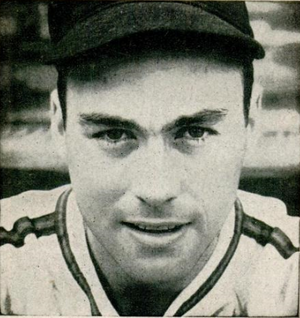Bob Kennedy facts for kids
Quick facts for kids Bob Kennedy |
|||
|---|---|---|---|

Bob Kennedy in 1947
|
|||
| Outfielder / Third baseman / Manager | |||
| Born: August 18, 1920 Chicago, Illinois, U.S. |
|||
| Died: April 7, 2005 (aged 84) Mesa, Arizona, U.S. |
|||
|
|||
| debut | |||
| September 14, 1939, for the Chicago White Sox | |||
| Last appearance | |||
| September 29, 1957, for the Brooklyn Dodgers | |||
| MLB statistics | |||
| Batting average | .254 | ||
| Home runs | 63 | ||
| Runs batted in | 514 | ||
| Managerial record | 264–278 | ||
| Winning % | .487 | ||
| Teams | |||
As player
As manager
|
|||
| Career highlights and awards | |||
|
|||
Robert Daniel Kennedy (born August 18, 1920 – died April 7, 2005) was a famous American baseball player, manager, and executive. He played in Major League Baseball (MLB) for many years.
From 1939 to 1957, Kennedy played for several teams. These included the Chicago White Sox, Cleveland Indians, Baltimore Orioles, Detroit Tigers, and Brooklyn Dodgers. He was known for batting and throwing with his right hand. After his playing days, Kennedy became a manager. He led the Chicago Cubs (1963–1965) and the Oakland Athletics (1968). His son, Terry Kennedy, also played in the major leagues as a catcher. Terry was even an All-Star four times!
Contents
Bob Kennedy: A Baseball Star
Playing Career Highlights
Early Days and World War II
Bob Kennedy was born in Chicago. He was a great hitter who could hit line drives. He also had a very strong and accurate throwing arm. Before he signed with the White Sox, he was a popcorn seller at Comiskey Park. He was only 16 years old at the time.
Kennedy started playing in the major leagues a year later. By 1940, he became the starting third baseman. In that year, he was the first teenager since 1900 to play 150 games in one season. After playing for a few years, he served in the military during World War II. When he returned, he mostly played in right field.
Winning the World Series
In the middle of the 1948 season, Kennedy was traded to the Cleveland Indians. He played very well for them, hitting .301 for the rest of the year. He became a key part of the 1948 World Series champion Indians team. This was the last time the Indians won the World Series for a long time.
His best season was in 1950. He had his highest batting average (.291) and most runs (79). He also had many hits (157) and doubles (27). In that same year, he helped start two triple plays from right field. This was a rare achievement!
Moving Teams and a Historic At-Bat
In 1954, Kennedy was traded to the new Baltimore Orioles team. On July 30, he hit the first grand slam for the Orioles. This was a big moment for the team.
In 1955, the White Sox bought Kennedy again. He was then sent to the Detroit Tigers in 1956. In 1957, he signed with the White Sox for his third time. A month later, he joined the Brooklyn Dodgers. He was released at the end of that season.
Bob Kennedy holds a special place in baseball history. He was the very last player to bat for the Brooklyn Dodgers. On September 29, 1957, in the 9th inning of their final game, Kennedy flew out to center field. The Dodgers lost that game 3-2 to the Philadelphia Phillies. After this game, the Brooklyn Dodgers moved to Los Angeles.
Life After Playing: Manager and Executive
Coaching the Chicago Cubs
After he stopped playing, Bob Kennedy became a scout for the Indians. He also directed their farm system, which helps young players develop. He managed the Triple-A Salt Lake City Bees team.
In 1962, Kennedy joined the Chicago Cubs as a coach. The Cubs had a unique system where several coaches ran the team instead of one manager. After a tough 1962 season, the Cubs owner named Kennedy the "head coach." He led the 1963 Cubs to their first winning season in 17 years. He managed the Cubs until June 1965.
Managing the Oakland Athletics
In 1968, the Oakland Athletics moved from Kansas City to Oakland. Bob Kennedy became their first manager in Oakland. The team finished with a winning record of 82 wins and 80 losses. This was a big improvement from their last-place finish in 1967. It was also the team's first winning season since 1952. Even with this success, Kennedy was fired after the season ended.
Working Behind the Scenes
After managing, Kennedy worked for several other baseball teams. He spent six years (1970–1975) with the St. Louis Cardinals. He helped develop players and manage personnel. In 1976, he joined the Seattle Mariners to help them prepare for their first season in 1977.
Kennedy returned to the Cubs in 1976 as their general manager. He was in charge of the team's baseball operations. He resigned from this role in 1981.
To finish his long baseball career, Kennedy worked as a senior executive for the Houston Astros (1982–1985) and San Francisco Giants (1986–1992). He helped his former teammate, Al Rosen, who was a president or general manager for those teams.
In his 16 years as a player, Kennedy had a .254 batting average. He hit 63 home runs and had 514 RBI in 1,483 games. As a manager, his record was 264 wins and 278 losses.
Bob Kennedy passed away in Mesa, Arizona, at the age of 84.

